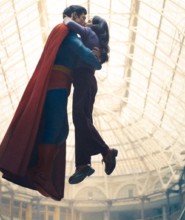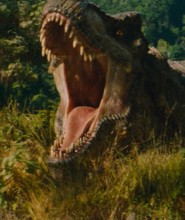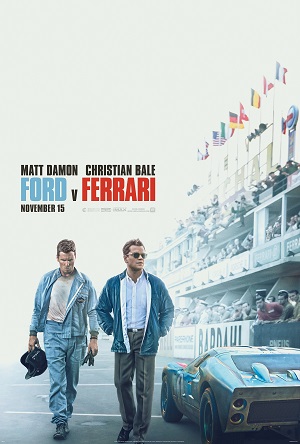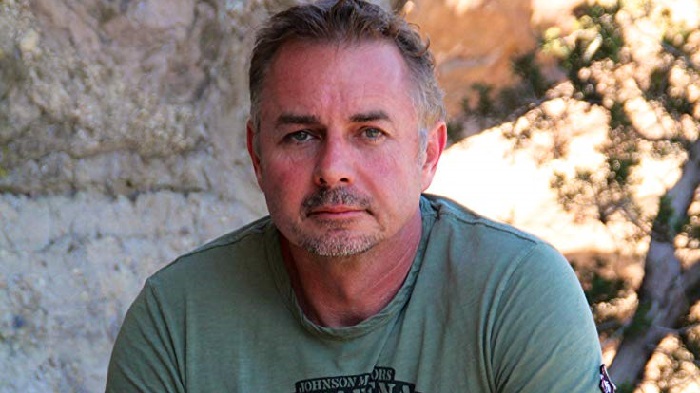
“Ford v Ferrari” – Interview with Robert Nagle
by Sara Michelle Fetters - November 23rd, 2019 - Interviews
Making it Real
Veteran stunt coordinator Robert Nagle chats about Ford v Ferrari
One of the reasons director James Mangold’s Ford v Ferrari is such an extraordinarily immersive cinematic achievement has everything to do with how it puts the viewer in the various vehicles (including the Shelby Cobra, the Ford GT40 and ‘60’s era Ferraris) driven throughout the film. The story of Ford Motor Company’s racing world battle against motorsports giant Ferrari in 1965 and 1966, notably focusing on custom sportscar designer Carroll Shelby (Matt Damon) and legendary driver Ken Miles (Christian Bale), the drama sprints across the screen like a high-octane blast of pure adrenalin.
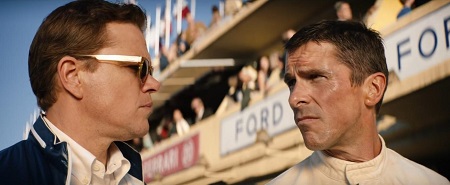
Veteran stunt driver, stuntman and stunt coordinator Robert Nagle was the man tasked by Mangold to breathe life into all of his film’s many racing and testing sequences. Doing so was a challenge he eagerly embraced. “Part of me still can’t believe this opportunity came my way,” Nagle quietly stated to me. “Mangold had a clear vision as to what he wanted but still gave me and my team a lot of freedom to create something incredible. I hope that’s what we did.”
I had the chance to chat with Nagle over the phone a day before the film’s nationwide release. Here are some edited excerpts from what he had to say:
Sara Michelle Fetters: So, I’m going to be totally unprofessional for about 60 seconds here and just say, holy cow! What an incredible job you and your entire team did on this film. I was blown away. Not gonna lie. I left the theatre gobsmacked.
Robert Nagle: [laughs] Why thank you! I really appreciate the recognition of the effort. We put a lot of work into this movie. A lot of work.
Sara Michelle Fetters: For you, as a veteran stunt performer and somebody who has just done some really extraordinary work in a lot of different films, when you came aboard this project, what was your vision for what you wanted to see accomplished? How did you work with James Mangold to make sure that that happened?
Robert Nagle: I really wanted, and it was important for James as well, that everything was grounded in reality and that we really conveyed to the audience what it was like to be in the middle of the race so they get a sense of what Ken Miles is dealing with. Also, each race had to have a different feel to it and there had to be an authentic reason for that. These were all ideas that were motivating us.
Sara Michelle Fetters: How much research goes into making sure that you’re staging these races similarly to what they were historically but also presenting them in a way that, as you said, that the audience felt like they were becoming part of the experience?
Robert Nagle: It started with the Willow Springs race, which was a completely fictitious race. I had a clean palette to just write that action as we needed it, to make it fun and exciting. It’s like a street fight. The race is just a little messier than the ones that come later in the film, like the 24 Hours at Le Mans.
That progresses into the next races. There were historical points we kind of wanted to stay true to, but at the same time we wanted to add some stuff. I come from the racing world, so I used my own experiences when choreographing these races. I also use some experiences from some of my guys driving those cars.
One of the crashes, Darrin Prescott, our second unit director, had been invited to participate in a celebrity race for Vipers by Dodge. I think this was probably eight, nine years ago. This huge wreck took place in front of him and a car was actually cartwheeling like we did in the film, debris going everywhere. He thought for sure he had just seen the driver die. It was that horrific.
[Darrin] was like, hey, let’s figure out a way to put this in the film, to convey how precarious this really is. It just seemed to fit what we were doing. At the start of these races, that’s why there’s so much tension. Just like that everything can just suddenly go wrong.Sara Michelle Fetters: When you’re doing all of this, obviously safety is the number one concern, but it still felt like a lot of this was done practically. How do you balance safety doing all of these practical stunts and how do you go about later augmenting them with digital effects? Where is the line between illusion and reality?
Robert Nagle: Well, on a certain level it’s all an illusion. These aren’t real races. We choreograph everything.
But to answer your question, it’s about having the right people and doing a lot of preparation and planning. You just go through the choreography step by step so that everybody understands where they need to be at any given moment. As long as that’s adhered to we take most of the risk out of it.
But we’re still dealing with mechanical machines and things do go wrong sometimes. That crash that I just spoke about, we did two takes and on the second one the car that was cartwheeling suddenly righted itself on its wheels and chased down the camera car that was filming it. It T-boned it and slammed it into the concrete wall and then subsequently into a tire wall. That was a pretty hard hit to the driver.
Sara Michelle Fetters: Yikes! That sounds terrifying. I imagine that had you all worried a little bit.
Robert Nagle: It did. He rung his bell pretty good. I sent him to the ER and made sure to get him checked out and that everything was okay. Head injuries are not something you want to play with. I’d rather be safe than sorry. Thankfully he came back with a clean bill of health.
Sara Michelle Fetters: Speaking of being safe, you worked with Christian for quite some time to ensure he was prepared to really play this character of Ken Miles. Do I have that correct?
Robert Nagle: You do. I was trying to put together options for his driver training. I felt the best way was to take him out to the Bob Bondurant School. It was kind of a twofold thing: It’s a great facility for training and it’s set up that way. They allowed me to shadow their instructor and guide the training the way I needed it.
But the big thing for me was that I wanted Christian to meet Bob Bondurant. He is from that era of racing. He’s a big player. He’s an icon. My hope was that we would be able to spend a couple of hours with Bob and Christian would get to meet him and that would be great because he actually knew Ken Miles. This was a great opportunity.
What ultimately happened is we would train from 7:00 in the morning till 1:00 or 2:00 in the afternoon and then we would spend the next four or five hours every day sitting down and talking with Bob. I thought they’d get like one conversation together and here we were doing this every single day.
One of the big surprises for me that I didn’t know was that he was very close friends with Ken Miles. I knew they were acquainted but I didn’t know just how much so. Bob had some amazing stories and information, and we got all of that. Just sitting down with him and talking, it was an incredible experience.
Sara Michelle Fetters: You’ve worked with a lot of actors preparing them to drive. Where does Christian rate?
Robert Nagle: Christian did an amazing. I’ve told everyone he’s hands-down the most accomplished driver I’ve trained as an actor to work in front of the camera. [laughs]
Honestly, though, he’s an incredible actor. It’s a testament to his talent that he took to the training as he did. He’s constantly challenging himself, but he does so incrementally and balanced with the proper dose of common sense. But he’s constantly pushing himself a little bit more, a little bit more, a little bit more and then a little bit more. He just did an amazing job.
I think one of the things that makes a great actor are the subtleties that they bring that you can’t always point to but that the subconscious picks up on. There is a difference from the beginning when they’re putting the car together to later on in the story inside the GT40. There is a difference in how Christian drives in the car and how he acts in it. That transformation is happening right there on the screen.
Sara Michelle Fetters: I hesitate to ask, but this is reportedly a $100-million or so production. Even with a budget like that and even with a major Hollywood studio backing the film, there is no way those were real Shelby Cobras and Ford GT40s and period Le Mans-era Ferrari’s. No way at all, right?
Robert Nagle: If they had been, the budget for the film would have likely been more like $700 or $800 million. [laughs] So, yeah, those are not the real cars. There’s no way you could afford vehicles like that to make a movie like this one.
As much as I would love to have had the real cars, no, these were all replicas. The Cobras you see were provided by Superformance and they’re an exact licensed replica. They’re an exact copy of what existed at that time. They gave us some of the GT40s as well. They’re licensed copies so they’re exactly the same. They had the 427s in them, the suspension, everything was period correct for the GT40s.
The Ferrari’s were from a different company and some of the other GT40s were from a third company. The Porsche’s were from a different company as well. Everything was replicated for Daytona and Le Mans. Every single vehicle.
However, for the Willow Springs race we did have real period-correct Corvettes that were made race-ready for us. That was definitely a thrill. Also, I personally test drove just about every car. I wanted to get a feel for how they were going to handle and what they were going to do before we completed choreographing each race. It’s interesting how those cars work or don’t work compared to something more contemporary.
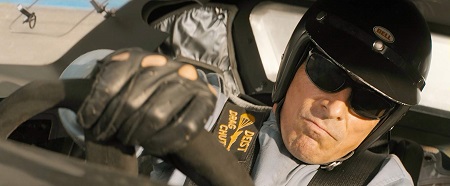
Sara Michelle Fetters: How do you compare, or can you even compare, what your stunt team did here in relation to what John Frankenheimer accomplished on a picture like 1966’s Grand Prix where they didn’t have the same kind of safety controls or the digital-augmentation resources that you have now?
Robert Nagle: My goal was to at least come close to what they did for Grand Prix. They did an amazing job. It was something I looked at several times before I sat down and started writing some of the stories for the races. There was always this nagging thing in the back of my mind wondering how can we make it look that great. It’s just the bell standard for this kind of movie.
I got a huge compliment, and I apologize because I can’t remember the gentleman’s name, but he was an editor for Cinematographer Magazine and was close friends with Frankenheimer. He opened my interview and, off the record, just said he wanted me to know Frankenheimer would have been a huge fan of our work. That made the hair on my arms stand up. It was amazing to hear that.
Sara Michelle Fetters: What was your relationship like with James Mangold?
Robert Nagle: It was a really good relationship. He gave Darrin and I basically a free reign for the races. I just wrote a story for all three races, obviously with his approval, and we tweaked them a little bit so they could easily fit inside the larger story. These became the basis for all three races.
I would also talk to him about the racer mentality. This is how they think. These are the mind games they play. Stuff like that. It gave him a different perspective. He would come back at me and ask, “How do I convey this to the audience? How do I tell that story?” It became a challenge for me to figure the answers to those questions out. I would come back to him with all these options based on our discussions. I absolutely loved working with James. It was amazing.
Sara Michelle Fetters: For you, personally, what was this experience like making this movie?
Robert Nagle: I pinched myself every morning. I couldn’t believe it was really happening. It was an amazing experience. It was arduous. It was a lot of work. All of which made it super rewarding. I loved every minute of it.
– Interview reprinted courtesy of the SGN in Seattle
